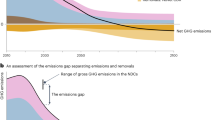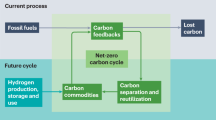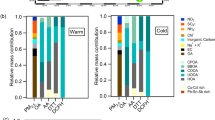Abstract
In 2014, China introduced an ultra-low emissions (ULE) standards policy for renovating coal-fired power-generating units to limit SO2, NOx and particulate matter (PM) emissions to 35, 50 and 10 mg m−3, respectively. The ULE standard policy had ambitious levels (surpassing those of all other countries) and implementation timeline. We estimate emission reductions associated with the ULE policy by constructing a nationwide, unit-level, hourly-frequency emissions dataset using data from a continuous emissions monitoring systems network covering 96–98% of Chinese thermal power capacity during 2014–2017. We find that between 2014 and 2017 China’s annual power emissions of SO2, NOx and PM dropped by 65%, 60% and 72%, respectively. Our estimated emissions using actual monitoring data are 18–92% below other recent estimates. We detail the technologies used to meet the ULE standards and the determinants of compliance, underscoring the importance of ex post evaluation and providing insights for other countries wishing to reduce their power emissions.
This is a preview of subscription content, access via your institution
Access options
Access Nature and 54 other Nature Portfolio journals
Get Nature+, our best-value online-access subscription
$29.99 / 30 days
cancel any time
Subscribe to this journal
Receive 12 digital issues and online access to articles
$119.00 per year
only $9.92 per issue
Buy this article
- Purchase on Springer Link
- Instant access to full article PDF
Prices may be subject to local taxes which are calculated during checkout




Similar content being viewed by others
Data availability
The CEAP database that supports the findings of this study is available at http://www.ieimodel.org/. Supplementary Data 2 presents a summary of the CEAP dataset. The data regarding the compilation of the CEAP dataset include CEMS data collected from the platforms listed in Supplementary Data 9, and the unit-specific information provided in Supplementary Data 10. The data regarding the estimation of emission factors and absolute emissions include the stack concentrations presented in Fig. 1, Supplementary Figs. 1–3 and Supplementary Data 3, the flue gas rates provided in Supplementary Data 7 and 8 and the unit information provided in Supplementary Data 10 and 11. The data regarding the analysis of the determinants of early ULE compliance (region, fuel and capacity) are presented in Supplementary Figs. 4–9.
Code availability
All computer codes generated during this study are available from the corresponding authors on reasonable request.
References
State of Global Air 2019 Special Report (Health Effects Institute, 2018).
World Bank and Institute for Health Metrics and Evaluation The Cost of Air Pollution: Strengthening the Economic Case for Action (World Bank, 2016).
Zhang, Q., He, K. & Huo, H. Cleaning China’s air. Nature 484, 161–162 (2012).
Zhao, Y., Zhang, J. & Nielsen, C. P. The effects of recent control policies on trends in emissions of anthropogenic atmospheric pollutants and CO2 in China. Atmos. Chem. Phys. Discuss. 12, 24985–25036 (2012).
Zheng, B. et al. Trends in China’s anthropogenic emissions since 2010 as the consequence of clean air actions. Atmos. Chem. Phys. 18, 14095–14111 (2018).
Klimont, Z. et al. Global anthropogenic emissions of particulate matter including black carbon. Atmos. Chem. Phys. 17, 8681–8723 (2017).
Lu, Z., Zhang, Q. & Streets, D. G. Sulfur dioxide and primary carbonaceous aerosol emissions in China and India, 1996-2010. Atmos. Chem. Phys. 11, 9839–9864 (2011).
Li, M. et al. MIX: a mosaic Asian anthropogenic emission inventory under the international collaboration framework of the MICS-Asia and HTAP. Atmos. Chem. Phys. 17, 34813–34869 (2017).
Ministry of Ecology and Environment of the People’s Republic of China China Environmental Statistical Yearbooks 2010–2015 (China Environmental, 2010–2015).
Xia, Y., Zhao, Y. & Nielsen, C. P. Benefits of China’s efforts in gaseous pollutant control indicated by the bottom-up emissions and satellite observations 2000–2014. Atmos. Environ. 136, 43–53 (2016).
Zhao, B. et al. NOx emissions in China: historical trends and future perspectives. Atmos. Chem. Phys. 13, 9869–9897 (2013).
Huang, R. et al. High secondary aerosol contribution to particulate pollution during haze events in China. Nature 514, 218–222 (2014).
Ministry of Ecology and Environment of the People’s Republic of China Emission Standard of Air Pollutants for Thermal Power Plants GB13223-2011 (China Environmental, 2011) (in Chinese).
National Development and Reform Commission, Ministry of Ecology and Environment of the People’s Republic of China & National Energy Administration Upgrade and Retrofit Plan for Coal-Fired Power Plants Aiming at Energy Savings and Emissions Reduction for 2014–2020 (National Development and Reform Commission, 2014) (in Chinese).
Ministry of Ecology and Environment of the People’s Republic of China Guideline on Available Technologies of Pollution Prevention and Control for Thermal Power Plant (China Environmental Science, 2017).
Ministry of Ecology and Environment of the People’s Republic of China, National Development and Reform Commission & National Energy Administration Work Plan of Full Implementing Ultra-Low Emission Policy and Energy Saving Transformation for Coal-Fired Power Plants (Ministry of Ecology and Environment of the People’s Republic of China, 2015) (in Chinese).
National Development and Reform Commission & National Energy Administration Revolutionary Strategy for Energy Production and Consumption (2016–2030) (National Development and Reform Commission, 2016) (in Chinese).
Gao, J. et al. Improving air pollution control policy in China—a perspective based on cost–benefit analysis. Sci. Total Environ. 543, 307–314 (2016).
China’s Energy Administration Action Plan for Clean and Efficient Use of Coal (2015–2020) (China’s Energy Administration, 2015) (in Chinese).
Yang, H. et al. Cost estimate of the multi-pollutant abatement in coal-fired power sector in China. Energy 161, 523–535 (2018).
Wang, C., Olsson, G. & Liu, Y. Coal-fired power industry water-energy-emission nexus: a multi-objective optimization. J. Clean. Prod. 203, 367–375 (2018).
Ni, Z. et al. Potential air quality improvements from ultralow emissions at coal-fired power plants in China. Aerosol Air Qual. Res. 18, 1944–1951 (2018).
Lin, C. et al. A global perspective on sulfur oxide controls in coal-fired power plants and cardiovascular disease. Sci. Rep. 8, 2611 (2018).
Li, M. & Patiño-Echeverri, D. Estimating benefits and costs of policies proposed in the 13th FYP to improve energy efficiency and reduce air emissions of China’s electric power sector. Energy Policy 111, 222–234 (2017).
Tong, D. et al. Targeted emission reductions from global super-polluting power plant units. Nat. Sustain. 1, 59–68 (2018).
Liu, F. et al. High-resolution inventory of technologies, activities, and emissions of coal-fired power plants in China from 1990 to 2010. Atmos. Chem. Phys. 15, 13299–13317 (2015).
Chen, L. et al. Unit-based emission inventory and uncertainty assessment of coal-fired power plants. Atmos. Environ. 99, 527–535 (2014).
Zhao, Y. et al. Primary air pollutant emissions of coal-fired power plants in China: current status and future prediction. Atmos. Environ. 42, 8442–8452 (2008).
Wang, S. et al. Growth in NOX emissions from power plants in China: bottom-up estimates and satellite observations. Atmos. Chem. Phys. 12, 4429–4447 (2012).
Tian, H. et al. Nitrogen oxides emissions from thermal power plants in China: current status and future predictions. Environ. Sci. Technol. 47, 11350–11357 (2013).
Karplus, V. J., Zhang, S. & Almond, D. Quantifying coal power plant responses to tighter SO2 emissions standards in China. Proc. Natl Acad. Sci. USA 115, 7004–7009 (2018).
Environmental Protection Tax Law (National People’s Congress of the People’s Republic of China, 2016) (in Chinese).
Sui, Z. et al. Fine particulate matter emission and size distribution characteristics in an ultra-low emission power plant. Fuel 185, 863–871 (2016).
China Electricity Council China Power Industry Annual Development Report 2015-2018 (China Market, 2015–2018).
Driscoll, C. T. et al. US power plant carbon standards and clean air and health co-benefits. Nat. Clim. Chang. 5, 535–540 (2015).
Bo, X. et al. Aviation’s emissions and contribution to the air quality in China. Atmos. Environ. 201, 121–131 (2019).
Yuan, X., Zhang, M., Wang, Q., Wang, Y. & Zuo, J. Evolution analysis of environmental standards: effectiveness on air pollutant emissions reduction. J. Clean. Prod. 149, 511–520 (2017).
Duflo, E., Greenstone, M., Pande, R. & Ryan, N. Truth-telling by third-party auditors and the response of polluting firms: experimental evidence from India. Q. J. Econ. 128, 1499–1545 (2013).
Ministry of Ecology and Environment of the People’s Republic of China Emission Standard of Air Pollutants for Thermal Power Plants GB13223-2003 (China Environmental, 2003) (in Chinese).
Ministry of Ecology and Environment of the People’s Republic of China Emission Standard of Air Pollutants for Thermal Power Plants GB13223-1996 (China Environmental, 1996) (in Chinese).
Guide of Maintenance for Power Plant Equipment (Ministry of Commerce of the People’s Republic of China, 2003) (in Chinese).
Specifications for Continuous Emissions Monitoring of Flue Gas Emitted from Stationary Sources HJ/T 75-2007 (Ministry of Ecology and Environment of the People’s Republic of China, 2007) (in Chinese).
Zhao, Y. et al. Establishment of a database of emission factors for atmospheric pollutants from Chinese coal-fired power plants. Atmos. Environ. 44, 1515–1523 (2010).
China Pollution Source Census Manual of the First National Pollution Source Census on Emission Factors from Industrial Pollution Sources (China Environmental Science, 2011) (in Chinese).
Gilbert, A. Q. & Sovacool, B. K. Benchmarking natural gas and coal-fired electricity generation in the United States. Energy 134, 622–628 (2017).
Liu, Z. et al. Reduced carbon emission estimates from fossil fuel combustion and cement production in China. Nature 524, 335–338 (2015).
National Bureau of Statistics China Energy Statistical Yearbook (China Statistics, 2017) (in Chinese).
National Development and Reform Commission & National Energy Administration Notice of Implementing Pilots for Spot Electricity Market (National Development and Reform Commission, 2017) (in Chinese).
Frey, H. C. & Zheng, J. Quantification of variability and uncertainty in air pollutant emission inventories: method and case study for utility NOX emissions. J. Air Waste Manag. Assoc. 52, 1083–1095 (2002).
Streets, D. et al. An inventory of gaseous and primary aerosol emissions in Asia in the year 2000. J. Geophys. Res. Atmos. 108(D21), 1984–2012 (2003).
Tang, L., Wu, J., Yu, L. & Bao, Q. Carbon emissions trading scheme exploration in China: a multi-agent-based model. Energy Policy 81, 152–169 (2015).
Zhao, Y., Nielsen, C. P., Lei, Y., McElroy, M. B. & Hao, J. Quantifying the uncertainties of a bottom-up emission inventory of anthropogenic atmospheric pollutants in China. Atmos. Chem. Phys. 11, 2295–2308 (2011).
National Development and Reform Commission & National Energy Administration China's 13th Five-Year Plan (2016-2020) for Power Sector Development (National Development and Reform Commission, 2017) (in Chinese).
Acknowledgements
This work was supported by grants from the National Science Foundation for Outstanding Young Scholars (71622011), the National Natural Science Foundation of China (71971007, 71988101 and 11771012), the National Programme for Support of Top Notch Young Professionals and the National Research Programme for Key Issues in Air Pollution Control (DQGG-05-07).
Author information
Authors and Affiliations
Contributions
L.T., Z.M., X.B. and S.W. designed the research. X.B., S.L. and X.Z. processed and analysed the data of the continuous emissions monitoring systems. X.W. compiled and analysed the unit-specific information for Chinese power plants. L.T., J.Q., X.C. and X.X. conducted the experimental work. L.T., Z.M. and L.D.A. wrote the paper. All authors contributed to developing and writing the manuscript.
Corresponding authors
Ethics declarations
Competing interests
The authors declare no competing interests.
Additional information
Publisher’s note Springer Nature remains neutral with regard to jurisdictional claims in published maps and institutional affiliations.
Supplementary information
Supplementary Information
Supplementary Notes 1–5, Figs. 1–9 and refs 1–28.
Supplementary Data
Supplementary Data 1–11.
Rights and permissions
About this article
Cite this article
Tang, L., Qu, J., Mi, Z. et al. Substantial emission reductions from Chinese power plants after the introduction of ultra-low emissions standards. Nat Energy 4, 929–938 (2019). https://doi.org/10.1038/s41560-019-0468-1
Received:
Accepted:
Published:
Issue Date:
DOI: https://doi.org/10.1038/s41560-019-0468-1



